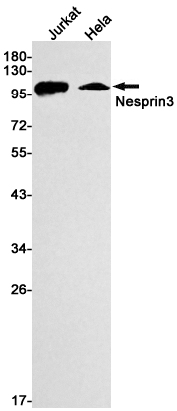
| WB | 1/500-1/1000 | Human,Mouse,Rat |
| IF | 咨询技术 | Human,Mouse,Rat |
| IHC | 咨询技术 | Human,Mouse,Rat |
| ICC | 技术咨询 | Human,Mouse,Rat |
| FCM | 咨询技术 | Human,Mouse,Rat |
| Elisa | 咨询技术 | Human,Mouse,Rat |
| Aliases | KASH3; NET53; Nesp3; C14orf49; C14orf139; LINC00341; NCRNA00341 |
| Entrez GeneID | 161176 |
| WB Predicted band size | Calculated MW: 112 kDa; Observed MW: 112 kDa |
| Host/Isotype | Rabbit IgG |
| Antibody Type | Primary antibody |
| Storage | Store at 4°C short term. Aliquot and store at -20°C long term. Avoid freeze/thaw cycles. |
| Species Reactivity | Human |
| Immunogen | Recombinant protein of human Nesprin3 |
| Formulation | Purified antibody in TBS with 0.05% sodium azide,0.05%BSA and 50% glycerol. |
+ +
以下是3篇关于Nesprin3抗体的文献概览(文献名称、作者及摘要简述):
---
1. **文献名称**:*Nesprin-3 regulates endothelial cell morphology and perinuclear cytoskeletal architecture*
**作者**:Ketema, M., et al. (2007)
**摘要**:该研究通过免疫荧光和免疫印迹技术,验证Nesprin3抗体特异性,发现Nesprin3通过连接核膜与细胞质中的微丝网络,调控内皮细胞形态和迁移能力。
---
2. **文献名称**:*Nesprin-3. a novel outer nuclear membrane protein, associates with the cytoskeletal linker protein plectin in epithelial cells*
**作者**:Wilhelmsen, K., et al. (2005)
**摘要**:首次报道Nesprin3抗体在HeLa细胞中的定位研究,揭示Nesprin3通过与细胞骨架蛋白plectin相互作用,参与细胞核与细胞质间机械信号的传递。
---
3. **文献名称**:*The LINC complex component Nesprin-3 regulates breast cancer cell migration*
**作者**:Borrego-Pinto, J., et al. (2016)
**摘要**:利用Nesprin3抗体进行功能缺失实验,证明Nesprin3通过整合核-细胞骨架连接复合体(LINC复合体),影响乳腺癌细胞的定向迁移和侵袭能力。
---
**备注**:若需获取全文或更多文献,建议通过PubMed或Google Scholar以关键词“Nesprin3 antibody”或“Nesprin3 function”检索。部分研究可能涉及抗体在疾病模型(如癌症、肌营养不良症)中的应用。
Nesprin-3 (nuclear envelope spectrin repeat protein 3), encoded by the SYNE3 gene, is a component of the LINC (linker of nucleoskeleton and cytoskeleton) complex that bridges the nuclear envelope and connects the nuclear lamina to the cytoskeleton. It contains a conserved KASH (Klarsicht/ANC-1/Syne homology) domain at its C-terminus, enabling interaction with SUN domain proteins in the inner nuclear membrane. Nesprin-3 primarily localizes to the outer nuclear membrane and facilitates nuclear positioning, mechanical signaling, and cell migration by linking the nucleus to the actin cytoskeleton through its interaction with plectin, a cytoskeletal crosslinker protein.
Antibodies targeting Nesprin-3 are essential tools for studying its role in cellular architecture, nuclear-cytoskeletal coupling, and mechanotransduction. They are widely used in techniques like immunofluorescence, Western blotting, and immunoprecipitation to visualize subcellular localization, assess protein expression levels, and identify interaction partners. Research involving Nesprin-3 antibodies has highlighted its involvement in cellular processes such as cell polarization, wound healing, and cancer cell invasion. Dysregulation of Nesprin-3 has been implicated in pathological conditions, including muscular dystrophies, cardiomyopathies, and metastatic cancers, making these antibodies valuable for investigating disease mechanisms. Commercial Nesprin-3 antibodies are typically validated for specificity using knockout cell lines or siRNA-mediated knockdown to ensure reliable detection across experimental models.
×